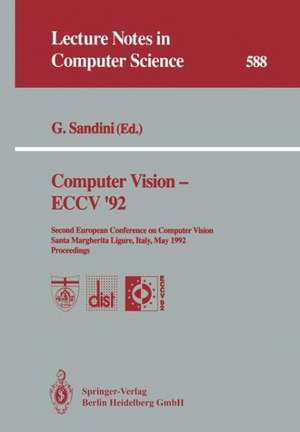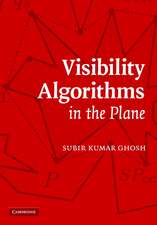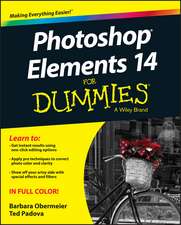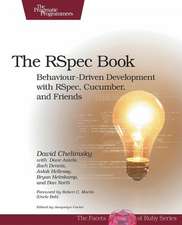Computer Vision — ECCV ’92: Second European Conference on Computer Vision Santa Margherita Ligure, Italy, May 19–22, 1992 Proceedings: Lecture Notes in Computer Science, cartea 588
Editat de Giulio Sandinien Limba Engleză Paperback – 29 apr 1992
Din seria Lecture Notes in Computer Science
- 20%
 Preț: 1061.55 lei
Preț: 1061.55 lei - 20%
 Preț: 307.71 lei
Preț: 307.71 lei - 20%
 Preț: 438.69 lei
Preț: 438.69 lei - 20%
 Preț: 579.30 lei
Preț: 579.30 lei -
 Preț: 410.88 lei
Preț: 410.88 lei - 17%
 Preț: 427.22 lei
Preț: 427.22 lei - 20%
 Preț: 596.46 lei
Preț: 596.46 lei - 15%
 Preț: 448.04 lei
Preț: 448.04 lei - 20%
 Preț: 353.50 lei
Preț: 353.50 lei -
 Preț: 389.49 lei
Preț: 389.49 lei - 20%
 Preț: 309.90 lei
Preț: 309.90 lei - 20%
 Preț: 645.28 lei
Preț: 645.28 lei - 20%
 Preț: 763.23 lei
Preț: 763.23 lei - 15%
 Preț: 580.46 lei
Preț: 580.46 lei - 20%
 Preț: 310.28 lei
Preț: 310.28 lei - 20%
 Preț: 655.02 lei
Preț: 655.02 lei - 20%
 Preț: 1183.14 lei
Preț: 1183.14 lei - 20%
 Preț: 340.32 lei
Preț: 340.32 lei -
 Preț: 449.57 lei
Preț: 449.57 lei - 20%
 Preț: 591.51 lei
Preț: 591.51 lei - 18%
 Preț: 938.83 lei
Preț: 938.83 lei - 20%
 Preț: 337.00 lei
Preț: 337.00 lei - 20%
 Preț: 649.50 lei
Preț: 649.50 lei - 20%
 Preț: 607.40 lei
Preț: 607.40 lei - 20%
 Preț: 1414.79 lei
Preț: 1414.79 lei - 20%
 Preț: 1024.44 lei
Preț: 1024.44 lei - 20%
 Preț: 583.40 lei
Preț: 583.40 lei - 20%
 Preț: 453.32 lei
Preț: 453.32 lei - 20%
 Preț: 575.49 lei
Preț: 575.49 lei - 20%
 Preț: 1075.26 lei
Preț: 1075.26 lei - 20%
 Preț: 585.88 lei
Preț: 585.88 lei - 20%
 Preț: 825.93 lei
Preț: 825.93 lei - 17%
 Preț: 360.20 lei
Preț: 360.20 lei - 20%
 Preț: 763.23 lei
Preț: 763.23 lei - 20%
 Preț: 340.32 lei
Preț: 340.32 lei - 20%
 Preț: 504.58 lei
Preț: 504.58 lei - 20%
 Preț: 369.13 lei
Preț: 369.13 lei - 20%
 Preț: 580.93 lei
Preț: 580.93 lei - 20%
 Preț: 343.62 lei
Preț: 343.62 lei - 20%
 Preț: 350.21 lei
Preț: 350.21 lei - 20%
 Preț: 583.40 lei
Preț: 583.40 lei - 20%
 Preț: 583.40 lei
Preț: 583.40 lei - 15%
 Preț: 438.59 lei
Preț: 438.59 lei - 20%
 Preț: 341.95 lei
Preț: 341.95 lei - 20%
 Preț: 238.01 lei
Preț: 238.01 lei - 20%
 Preț: 538.30 lei
Preț: 538.30 lei
Preț: 369.99 lei
Preț vechi: 462.48 lei
-20% Nou
Puncte Express: 555
Preț estimativ în valută:
70.81€ • 76.88$ • 59.48£
70.81€ • 76.88$ • 59.48£
Carte tipărită la comandă
Livrare economică 22 aprilie-06 mai
Preluare comenzi: 021 569.72.76
Specificații
ISBN-13: 9783540554264
ISBN-10: 3540554262
Pagini: 925
Ilustrații: XV, 912 p.
Dimensiuni: 170 x 244 mm
Greutate: 1.45 kg
Ediția:1992
Editura: Springer Berlin, Heidelberg
Colecția Springer
Seria Lecture Notes in Computer Science
Locul publicării:Berlin, Heidelberg, Germany
ISBN-10: 3540554262
Pagini: 925
Ilustrații: XV, 912 p.
Dimensiuni: 170 x 244 mm
Greutate: 1.45 kg
Ediția:1992
Editura: Springer Berlin, Heidelberg
Colecția Springer
Seria Lecture Notes in Computer Science
Locul publicării:Berlin, Heidelberg, Germany
Public țintă
ResearchCuprins
Steerable-scalable kernels for edge detection and junction analysis.- Families of tuned scale-space kernels.- Contour extraction by mixture density description obtained from region clustering.- The Möbius strip parameterization for line extraction.- Edge tracing in a priori known direction.- Features extraction and analysis methods for sequences of ultrasound images.- Figure-ground discrimination by mean field annealing.- Deterministic pseudo-annealing: Optimization in Markov-Random-Fields an application to pixel classification.- A Bayesian multiple hypothesis approach to contour grouping.- Detection of general edges and keypoints.- Distributed belief revision for adaptive image processing regulation.- Finding face features.- Detection of specularity using color and multiple views.- Data and model-driven selection using color regions.- Recovering shading from color images.- Shading flows and scenel bundles: A new approach to shape from shading.- Texture: Plus ça change, ....- Texture parametrization method for image segmentation.- Texture segmentation by minimizing vector-valued energy functionals: The Coupled-Membrane model.- Boundary detection in piecewise homogeneous textured images.- Surface orientation and time to contact from image divergence and deformation.- Robust and fast computation of unbiased intensity derivatives in images.- Testing computational theories of motion discontinuities: A psychophysical study.- Motion and structure factorization and segmentation of long multiple motion image sequences.- Motion and surface recovery using curvature and motion consistency.- Finding clusters and planes from 3D line segments with application to 3D motion determination.- Hierarchical model-based motion estimation.- A fast method to estimate sensor translation.- Identifying multiple motions from optical flow.- A fast obstacle detection method based on optical flow.- A parallel implementation of a structure-from-motion algorithm.- Structure from motion using the ground plane constraint.- Detecting and tracking multiple moving objects using temporal integration.- A study of affine matching with bounded sensor error.- Epipolar line estimation.- Camera calibration using multiple images.- Camera self-calibration: Theory and experiments.- Model-based object pose in 25 lines of code.- Image blurring effects due to depth discontinuitites: Blurring that creates emergent image details.- Ellipse based stereo vision.- Applying two-dimensional delaunay triangulation to stereo data interpolation.- Local stereoscopic depth estimation using ocular stripe maps.- Depth computations from polyhedral images.- Parallel algorithms for the distance transformation.- A computational framework for determining stereo correspondence from a set of linear spatial filters.- On visual ambiguities due to transparency in motion and stereo.- A deterministic approach for stereo disparity calculation.- Occlusions and binocular stereo.- Model-based object tracking in traffic scenes.- Tracking moving contours using energy-minimizing elastic contour models.- Tracking points on deformable objects using curvature information.- An egomotion algorithm based on the tracking of arbitrary curves.- Region-based tracking in an image sequence.- Combining intensity and motion for incremental segmentation and tracking over long image sequences.- Active egomotion estimation: A qualitative approach.- Active perception using DAM and estimation techniques.- Active/dynamic stereo for navigation.- Integrating primary ocular processes.- Where to look next using a Bayes net: Incorporating geometric relations.- An attentional prototype for early vision.- What can be seen in three dimensions with an uncalibrated stereo rig?.- Estimation of relative camera positions for uncalibrated cameras.- Gaze control for a binocular camera head.- Computing exact aspect graphs of curved objects: Algebraic surfaces.- Surface interpolation using wavelets.- Smoothing and matching of 3-D space curves.- Shape from texture for smooth curved surfaces.- Recognising rotationally symmetric surfaces from their outlines.- Using deformable surfaces to segment 3-D images and infer differential structures.- Finding parametric curves in an image.- Determining three-dimensional shape from orientation and spatial frequency disparities.- Using force fields derived from 3D distance maps for inferring the attitude of a 3D rigid object.- Segmenting unstructured 3D points into surfaces.- Finding the pose of an object of revolution.- Extraction of line drawings from gray value images by non-local analysis of edge element structures.- A method for the 3D reconstruction of indoor scenes from monocular images.- Active detection and classification of junctions by foveation with a head-eye system guided by the scale-space primal sketch.- A new topological classification of points in 3D images.- A theory of 3D reconstruction of heterogeneous edge primitives from two perspective views.- Detecting 3-D parallel lines for perceptual organization.- Integrated skeleton and boundary shape representation for medical image interpretation.- Critical sets for 3D reconstruction using lines.- Intrinsic surface properties from surface triangulation.- Edge classification and depth reconstruction by fusion of range and intensity edge data.- Image compression and reconstruction using a 1-D feature catalogue.- Canonical frames for planar object recognition.- Measuring the quality of hypotheses in model-based recognition.- Using automatically constructed view-independent relational model in 3D object recognition.- Learning to recognize faces from examples.- Face recognition through geometrical features.- Fusion through interpretation.- 3-D object recognition using passively sensed range data.- Interpretation of remotely sensed images in a context of multisensor fusion.- Limitations of non model-based recognition schemes.- Constraints for recognizing and locating curved 3D objects from monocular image features.- Polynomial-time object recognition in the presence of clutter, occlusion, and uncertainty.- Hierarchical shape recognition based on 3-D multiresolution analysis.- Object recognition by flexible template matching using genetic algorithms.- Matching and recognition of road networks from aerial images.- Intensity and edge-based symmetry detection applied to car-following.- Indexicality and dynamic attention control in qualitative recognition of assembly actions.- Real-time visual tracking for surveillance and path planning.- Spatio-temporal reasoning within a traffic surveillance system.- Template guided visual inspection.- Hardware support for fast edge-based stereo.






